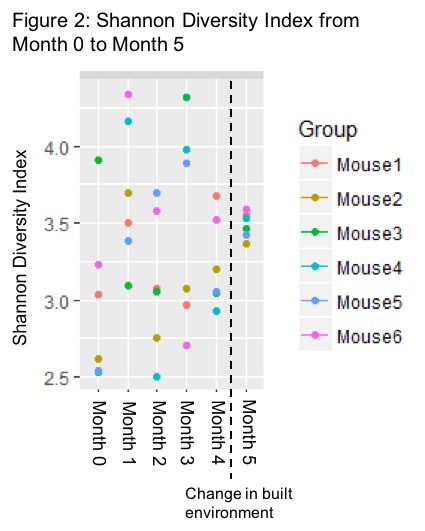Effects of time and the built environment on the stability of the mouse urinary microbiome: implications for clinical utility
Catherine S. Forster, MD1, James Cody, PhD2, Nirad Banskota, MS2, Crystal Stroud, MS1, Ljubica Caldovic, PhD1, Michael Hsieh, MD, PhD1.
1Children's National Medical Center, Washington, DC, USA, 2Biomedical Research Institute, Rockville, MD, USA.
Background: Emerging evidence suggests that the urinary microbiome, the bacterial milieu within the bladder, has significant implications in both health and disease of the genitourinary system. However, little is known about the temporal stability of the urinary microbiome, and how changes in the built environment affect the urinary microbiome. The objective of this study was to determine the stability of the mouse urinary microbiome over time and the effects of changes in the built environment on the urinary microbiome.
Methods: 6 C57BL/6 mice were followed for a 5-month period starting at 9 weeks of age. Single-voided urine specimens were collected at baseline (month 0), and then monthly for 5 months. Mice were housed together in one cage, and provided the same chow (ProLab RMH 1000) and water. Between month 4 and month 5, mice were moved to a new facility within the same county. Chow and bedding remained the same, but the water source changed as the mice were given tap water at both facilities. Microbial DNA was isolated from urine specimens, and sequencing of the 16S rRNA V4 region of the bacterial DNA completed using Illumina MiSeq. The composition and diversity of the urinary microbiomes were compared between time points and between specific mice. PICRUST was used for functional analysis of the microbiota.
Results: There was no changes in the proportion of specific bacteria in the urinary microbiomes from month 0 through month 5. Principal coordinate analysis (PCoA) demonstrated clustering for the microbiomes in month 5: no other clustering was seen, either by month or by mouse (Figure 1). There was no significant difference in the Shannon Diversity Index between months, although convergence is seen at month 5. (Figure 2) PICRUST demonstrated alteration in functional pathways between months 0,1,2,3 and month 5, with the most consistent increases in ribosome biosynthesis, bacterial toxins, and streptomycin biosynthesis in month 5.
Conclusion: There is stability of the urinary microbiomes of healthy mice over time. There were no differences in specific bacteria as a result of the change in the built environment. However, the convergence of the Shannon Diversity Index, the clustering seen on PCoA, and the changes in the functional analysis suggest that an overall shift of the urinary microbiome occurred as a result of change in the physical environment. These findings have important implications for ongoing clinical studies of the urinary microbiome in pediatric and adult patients, including longitudinal work in patients prone to chronic and recurrent bacteriuria. 

Back to 2018 Program




